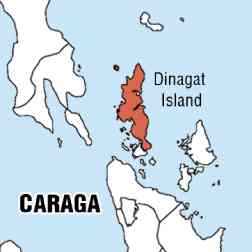Election 2016: Agenda of the Dinagat Islands representative
The Inquirer is coming out today with the 20th in its series on pressing people’s concerns that should be high on the agenda of candidates for representative, governor or mayor in the May 9 elections. The series should help voters in the provinces choose their leaders wisely. In line with our “ThINQ. Vote.” advocacy, we have asked candidates in certain provinces, cities and congressional districts to outline their concrete plans of action in dealing with specific issues in their areas.
Profile: Province of Dinagat Islands
Dinagat Islands is one of the newest provinces in the country and one of the smallest, with an area of 80,205 hectares. It has seven towns and 100 villages with a total population of 126,803 (2010).
The entire island group was declared a mineral reservation through Proclamation No. 391 issued by the late President Manuel Quezon in 1939. At least 22 percent of the land area is classified as alienable and disposable while the rest is mineral land with existing mining claims. Eight large-scale nickel mining companies are operating in the province.
Article continues after this advertisementAccording to a geohazard assessment by the Mines and Geosciences Bureau, 91 percent of the total land area is prone to rain-induced landslides and 64 percent to ground shaking. About 6,000 hectares are flood-prone and 33,000 ha tsunami-prone.
Article continues after this advertisementDinagat is home to at least 20 threatened species of animals and plants, 13 of them endemic to the Philippines. In 2006, Mt. Redondo and Mt. Kambinliw were listed among the 117 key biodiversity areas under the Philippine Biodiversity Conservation Priority-setting Program.
Aside from seasonal employment provided by the mining industry, residents make a living through farming, fishing and handicraft.
CONCERN 1: ENVIRONMENT
MINING AND BIODIVERSITY. Dinagat’s special status as a mining reservation makes it vulnerable to environmental damage. At least 10 watersheds, forest reserves and other ecotourism areas identified by local government units are within the approved tenements of 12 large-scale mining companies. Degradation of watersheds and forests, siltation of coastal and other water bodies, as well as air pollution, are some of the major threats resulting from mining activities. Identification and delineation of important ecological features are needed to protect and preserve them.
Arlene “Kaka” Bag-ao (Liberal Party)
- Push for the protection of valuable watersheds through legislation and the assistance of national agencies. This will improve access to safe drinking water, which will be strengthened by upgrading water systems through participation in the budget process and coordination with local governments.
- Refile in Congress the National Land Use Act, the Alternative Minerals Management Bill and the Forest Resources Bill—“green” measures that will benefit not only Dinagat but the whole country as well.
- Continue critical engagement with mining companies to involve them in the conservation of watersheds and coastal areas and the development of communities around them.
CONCERN 2: ACCESS TO JUSTICE
JUDICIAL RELIEF. National line agencies that deliver crucial services to the provinces have not yet fully established their presence on Dinagat Islands, being one of the youngest provinces in the country. Even the judicial branch has not yet set up courts in the province. At present, residents seeking judicial relief have to endure a two-hour boat ride to Surigao City.
Bag-ao
- Ensure the administration of justice by creating a court, the first one in our province, and setting up prosecution offices and Public Attorneys Office.
- Strengthen paralegal training among Dinagatnons in consonance with the fundamental principle of empowerment by putting the law in the hands of the marginalized.
CONCERN 3: PROGRESS
LAST RUNG IN WEALTH LADDER. According to the 2014 financial report of the Commission on Audit, Dinagat remains at the bottom of the wealth ladder among provinces in the country. It ranked last among the 10 provinces that posted lowest equity, at P281.292 million. The COA defines equity as the difference between the amount of assets and liabilities of LGUs. It is a financial resource that may be saved or used for local projects such as infrastructure, investments and operating expenses.
Bag-ao
- Continue to improve access to government and its services to ensure that Dinagatnons will be able to participate in their own development.
- In coordination with the national government complete the road network and build a community college and a better hospital in our province.
Jade B. Ecleo (United Nationalist Alliance)
(Editor’s note: The Inquirer repeatedly tried to get Ecleo’s answers to the province’s top issues. After she was told that specifics were needed, she did not reply to text messages and e-mails. Last week, she e-mailed the following:
- Continue all road-widening projects since those are national projects with continuing appropriations.
- Expand scholarships and assist K-12 programs through the Jade Foundation.
- Create a state university in the province and provide free housing/accommodation for scholars outside the province.
- Improve hospital services and hire surgeons and other medical personnel so that patients will no longer travel to Surigao City for their medical needs.
- Provide sea ambulance through the Jade Foundation.
- Develop the province’s tourism potentials to generate employment for locals.)



